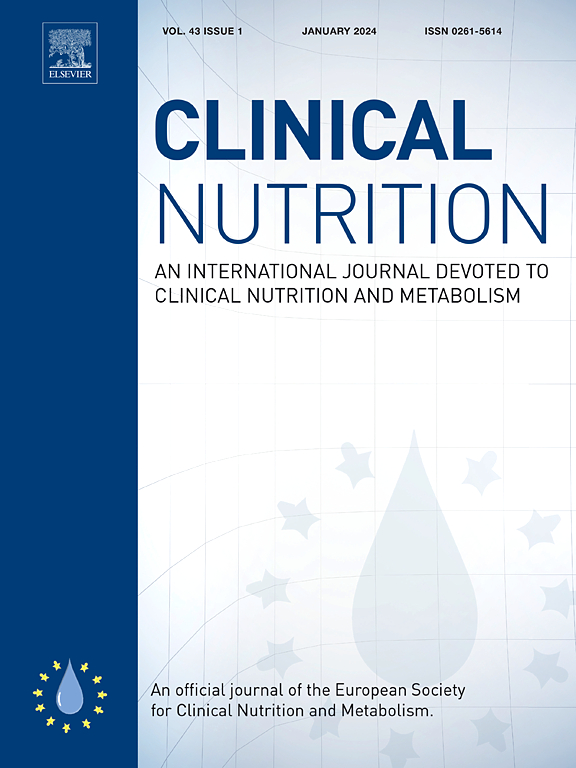饮食炎症和儿童肥胖:来自6个出生队列的个体参与者数据分析。
IF 6.6
2区 医学
Q1 NUTRITION & DIETETICS
引用次数: 0
摘要
背景与目的:儿童肥胖和炎症影响长期健康。然而,饮食炎症与儿童肥胖之间的关系尚不清楚。我们调查了在儿童早期、中期和晚期,更多的促炎饮食是否与更大的肥胖有关。方法:我们汇集了来自字母表联盟六个欧洲出生队列的13978名儿童的个体参与者数据(IPD):Lifeways跨代队列研究(Lifeways)、妊娠期间低血糖指数饮食随机对照试验(ROLO)、雅芳父母和儿童纵向研究(ALSPAC)、南安普顿妇女调查(SWS)、波兰母亲和儿童队列研究(REPRO_PL)和R代研究(Generation R)。使用儿童饮食炎症指数(C-DII™)确定饮食炎症。肥胖相关结局包括BMI z-score(主要结局)、腹围、皮肤褶皱、脂肪质量指数和无脂肪质量指数(次要结局)。采用调整后的线性和逻辑回归模型进行两阶段随机效应IPD荟萃分析(IPD- ma)。分位数回归(QR)检验C-DII与BMI z-score百分位数的关系。结果:中位数、25和75百分位C-DII得分从早期的0.18(-0.65,1.03)上升到儿童后期的0.51(-0.40,1.49)。合并QR显示C-DII与BMI z-score百分位数呈正相关,特别是在儿童期晚期未调整的β (95% CI) 75 (0.075 (0.046, 0.105), p结论:C-DII与BMI z-score分布的相关性因队列、分位数和时间点而异,其中一些可能由肥胖反弹、反向因果关系和问卷回答偏差解释,突出了线性回归不明显的见解。本文章由计算机程序翻译,如有差异,请以英文原文为准。
Dietary inflammation and childhood adiposity: Analysis of individual participant data from six birth cohorts
Background & aims
Childhood adiposity and inflammation impact long-term health. However, associations between dietary inflammation and childhood adiposity are unclear. We investigated if more pro-inflammatory diets are associated with greater adiposity in early-, mid-, and late-childhood.
Methods
We pooled individual participant data (IPD) from 13,978 children in six European birth cohorts in the ALPHABET consortium: Lifeways Cross-Generation Cohort Study (Lifeways), the Randomised cOntrol trial of LOw glycaemic index diet during pregnancy study (ROLO), the Avon Longitudinal Study of Parents and Children (ALSPAC), the Southampton Women's Survey (SWS), the Polish Mother and Child Cohort (REPRO_PL), and The Generation R Study (Generation R). Dietary inflammation was determined using the Children's Dietary Inflammatory Index (C-DII™). Adiposity-related outcomes included BMI z-score (primary outcome), abdominal circumference, skinfolds, fat-mass- and fat-free-mass-indices (secondary outcomes). Two-stage random effects IPD meta-analysis (IPD-MA), with adjusted linear and logistic regression models, was conducted. Quantile regression (QR) examined C-DII associations with BMI z-score percentiles.
Results
Median, 25th and 75th percentile C-DII scores trended upwards from early 0.18 (−0.65, 1.03) to late-childhood 0.51 (−0.40, 1.49). Pooled QR revealed positive C-DII associations across BMI z-score percentiles, particularly in late-childhood unadjusted β (95 % CI) 75th (0.075 (0.046, 0.105), p < 0.001); 85th (0.077 (0.045, 0.108), p < 0.001); and 95th (0.051 (0.011, 0.091), p = 0.01). Adjusted cohort-specific QR identified contrasting associations at early-childhood (ALSPAC and SWS) and late-childhood (Generation R). Pooled adjusted IPD-MA showed C-DII associations with late-childhood obesity [OR (95 % CI) 0.89 (0.81, 0.97), p = 0.01].
Conclusions
C-DII associations across BMI z-score distribution varied by cohort, quantile, and time-point, with some potentially explained by adiposity rebound, reverse causation and questionnaire response biases, highlighting insights not evident with linear regression.
求助全文
通过发布文献求助,成功后即可免费获取论文全文。
去求助
来源期刊

Clinical nutrition
医学-营养学
CiteScore
14.10
自引率
6.30%
发文量
356
审稿时长
28 days
期刊介绍:
Clinical Nutrition, the official journal of ESPEN, The European Society for Clinical Nutrition and Metabolism, is an international journal providing essential scientific information on nutritional and metabolic care and the relationship between nutrition and disease both in the setting of basic science and clinical practice. Published bi-monthly, each issue combines original articles and reviews providing an invaluable reference for any specialist concerned with these fields.
 求助内容:
求助内容: 应助结果提醒方式:
应助结果提醒方式:


